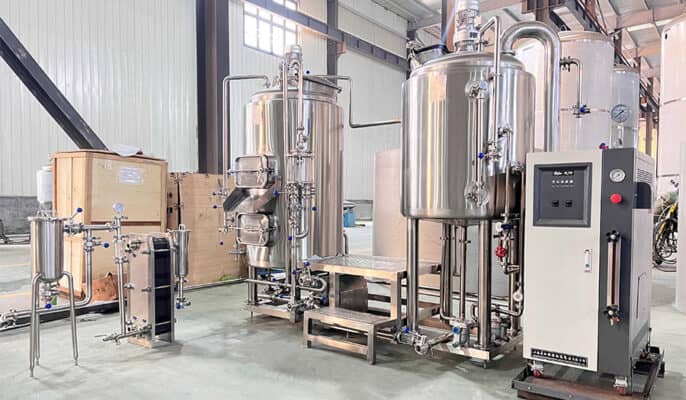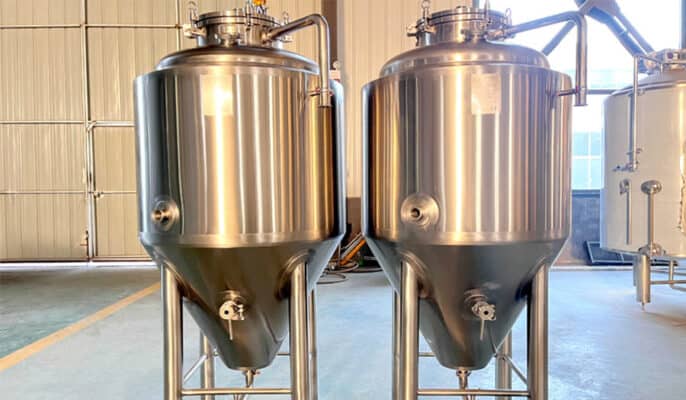Pivovarnictví je na vzestupu a stále více nadšenců posouvá svou vášeň pro skvělé pivo na vyšší úroveň a zakládá si minipivovar. K vaření lahodného piva budete potřebovat základní vybavení pro vaření a kvašení surovin. Ať už je váš důvod pro založení pivovaru jakýkoli, stojí před vámi jedna otázka - jak vybrat pivovarské vybavení? Rozhodnutí začít vařit pivo je vzrušující záležitost, ale může se zdát také docela skličující. Každá fáze procesu vaření piva vyžaduje jiné vybavení a také několik základních potřeb. Zde je komplexní průvodce nástroji, které potřebujete k vaření lahodného piva.
Určete velikost svého pivovaru
Všechny pivovary jsou závislé na vnějších kritériích, jako je rozpočet, plocha, trh a dokonce i místní předpisy. Přesto otevření malého pivovaru není vždy příjemné. Pokud začnete příliš malým pivovarem, budete mít později potíže s rozšiřováním svého podnikání. Mnoho pivovarů začíná s 5HL tanky a používá kombinaci 5HL a 10HL kvasných nádob. Pokud jste v pivním baru bez velkého počtu míst k sezení, může to stačit.
Vybavení potřebné k vaření piva
Varná konvice
Varný džbán je nezbytným nástrojem. Podle toho, jak velké várky obvykle vaříte, můžete zvolit konvici o objemu pět až dvacet litrů. Směs vody a sladu je třeba vařit, aby se ze sladu extrahovaly cukry. Kromě toho se ve stejném kotli bude vařit i chmel použitý v závěrečném kroku vaření. Proto je nejlepší mít varnou nádobu, která pojme alespoň čtyři galony tekutiny.
Důležitým faktorem, který je třeba zvážit, je materiálové složení varné nádoby, přičemž vhodnou volbou je měď i nerezová ocel. Zatímco nerezová ocel je levnější a vyžaduje méně údržby, měď díky svým katalytickým schopnostem zajistí lepší chuť piva.

Kvasné nádoby
A fermentační nádoba (FV) je tank, ve kterém kvasí pivo. Dnes je většina pivovarů vybavena monoblokovými tanky. Tyto tanky se používají ke kvašení a zrání piva.
Při kvašení mladiny na pivo je zapotřebí nádoba, která mladinu uchová. Kvašení piva lze provádět různými způsoby. K uskladnění hotového piva lze použít sudy, skleněné lahve nebo plastové kbelíky. Množství piva, které chcete uvařit, určuje velikost a tvar kvasné nádoby.
Jako nádoby, které se nejsnáze čistí, volíme plastové kbelíky nebo velké láhve s velkým prostorem nahoře. Sklo je žáruvzdornější než kovové nebo plastové nádoby. Pokud máte dostatek finančních prostředků, je nejlepší volbou nerezová ocel.
Přechodová komora
Do horní části fermentoru se vloží vzduchový uzávěr, který umožňuje únik oxidu uhličitého, vedlejšího produktu kvašení, z fermentoru, aniž by se do něj dostaly nečistoty. V závislosti na typu fermentoru je někdy nutné vzduchový uzávěr zajistit zátkou. Bez vzduchového uzávěru by tlak ve fermentoru mohl způsobit, že víko nebo zátka vyskočí, nebo ještě hůře, že fermentor exploduje!
Systém vytápění
Při vaření potřebujete hodně horké vody a možnost vařit mladinu v konvici. To znamená, že potřebujete topný systém. Na výběr máte elektrický nebo parní vařič. Pro větší pivovary je vždy lepší volbou pára nad 7HL.
Pára je levnější a poskytuje rovnoměrnější zdroj tepla. Při použití elektřiny může dojít ke karamelizaci mladiny v blízkosti topného tělesa, což ve většině případů není dobré.
Sifon/potrubí
Sifony a trubky jsou skvělým způsobem, jak zjednodušit přesun horké mladiny nebo hotového piva bez potíží a nepořádku při zvedání a nalévání velkého množství. Přečerpávají tekutinu z jedné nádoby do druhé, aniž by se do piva dostalo příliš mnoho kyslíku nebo jiných nečistot.
Výběr mixéru
Budete potřebovat sterilizovaný mixér s dlouhou rukojetí z nerezové oceli. Nepoužívejte dřevěné náčiní, protože může obsahovat mikroorganismy, které by mohly zkazit vaše pivo.

Jaké pomocné vybavení je potřeba?
CIP : Používá se k čištění fermentorů a BBT po jejich vyprázdnění a znečištění.
Odnímatelné čerpadlo: Slouží k čištění fermentoru a BBT a k přečerpávání piva z fermentoru do BBT.
Ovládací panel: K regulaci teploty fermentoru a pivovaru budete potřebovat ovládací panel.
Hadice: Pivní hadice jsou potřebné k přečerpávání piva z jedné nádrže do druhé a k čištění nádrží.
Jak dlouho trvá kvašení?
Kvašení se obvykle projeví až po jednom nebo dvou dnech a lze ho pozorovat podle velké husté pěny, která se objeví na povrchu tekutiny, a podle bublání ve vzdušníku, jak se vytlačuje přebytečný oxid uhličitý. Rychlost pěnění se snižuje s tím, jak se pěna vytváří, a přibližně po týdnu pěnění ustane. To znamená, že kvašení je ukončeno a můžete stáčet do lahví.
Nezapomeňte, že pokud potřebujete sud po zahájení kvašení přemístit, udělejte to a . Za prvé, je to velký a těžký kbelík, takže se snažte, abyste se nezranili nebo ho všude nerozlili. Za druhé je nejlepší nechat tam sediment, který se usazuje na dně, a míchání může přinést "pachy". Za třetí, nechcete, aby se pivo vylilo na víko, protože to může zvýšit riziko infekce.
Kolik stojí pivní vybavení?
Zahájení malý pivovar může být vzrušující a prospěšná, ale je nutné znát různé počáteční náklady a průběžné výdaje. Malé pivovary musí značně investovat, od průzkumu trhu a licencí až po vybavení, pracovní sílu a marketing. Počáteční náklady na malý pivovar se mohou lišit , v závislosti na faktorech, jako je umístění, velikost a vybavení. Malý pivovar může potřebovat investici přibližně $100 000, zatímco velký pivovar může potřebovat $1 milion nebo více.
Běžný problém
1.Potřebuji k otevření minipivovaru zvláštní licenci?
Ano, malé pivovary musí získat oznámení o výrobě piva od federálního úřadu TTB a také všechny potřebné státní a místní licence a povolení.
2.Jak dlouho trvá založení malého pivovaru?
Časový plán pro založení minipivovaru se může lišit v závislosti na faktorech, jako je lokalita, licenční požadavky a dodací lhůty zařízení. V průměru může zahájení provozu trvat od 6 měsíců do 2 let.
3.Jaké jsou ziskové marže malého pivovaru?
Ziskové marže malých pivovarů se mohou lišit, ale průměrné hodnoty v odvětví se pohybují mezi 5% a 20%. Mezi faktory, které ovlivňují ziskové marže, patří efektivita výroby, cenotvorba a marketingové strategie.





Toto je ta správná stránka pro každého, kdo by chtěl porozumět této problematice.
téma. Je toho tolik, že je téměř těžké s vámi nesouhlasit (ne že bych to opravdu chtěl... HaHa).
Přinášíte nový pohled na téma, o kterém se již mluvilo.
pro věkové kategorie. Skvělá věc, prostě eҳcellent!
Miloval jsem ještě víc, než tady uděláte. Obrázek je pěkný a vaše písmo je stylové, ale zdá se, že se tím řítíte, a myslím, že byste to měli brzy dát znovu. Pravděpodobně to udělám znovu a znovu, pokud budete chránit tuto procházku.
Tento raragraph je opravdu rychlý jeden to asѕists nové webové visitoгs, kteří si přejí ve prospěch blogování.
Ve skutečnosti, když někdo neví, pak je to pro ostatní uživatele, že
budou aѕsistovat, tak zde je taҝe místo.
Tady je peklo! Vím, že je to trochu mimo téma, ale napadlo mě, že se zeptám.
Wⲟuⅼd byste měli zájem o výměnu odkazů nebo možná hostující autorství
příspěvek na blogu nebo naopak? Moje stránky pokrývají lⲟt z
stejná témata jako vaše a mám pocit, že bychom mohli mít velký prospěch z eaⅽh druhé.
Pokud máte zájem, neváhejte mi napsat e-mail.
Těším se, až se ozvete! Mimochodem, skvělý blog!
Exceⅼlent příspěvek nicméně , Chtěl jsem vědět, jestli byste mohli napsat ⅼitte více na toto téma?
Byl bych vám velmi vděčný, kdybyste mi mohli trochu více přiblížit.
Mnohokrát děkujeme!